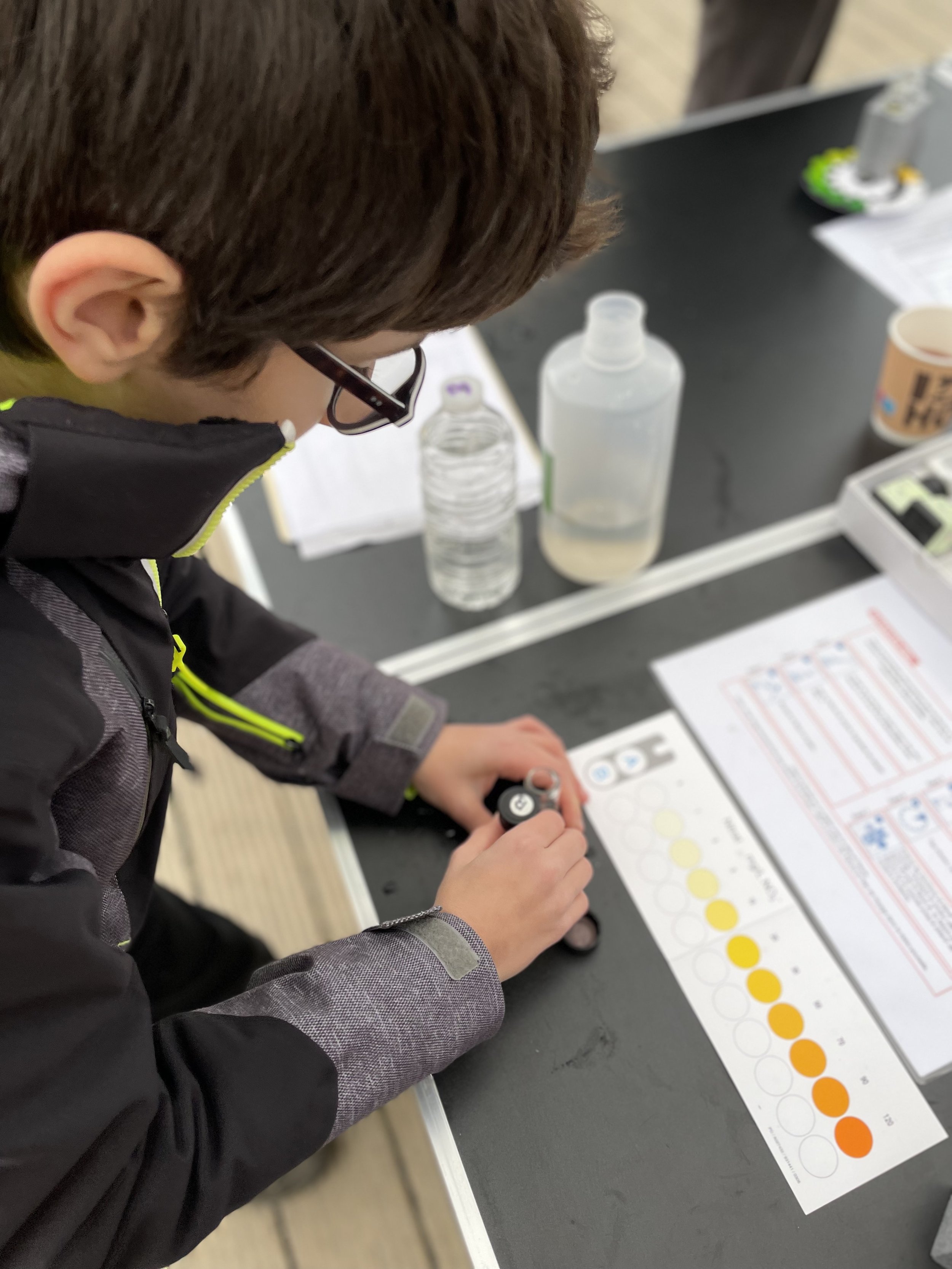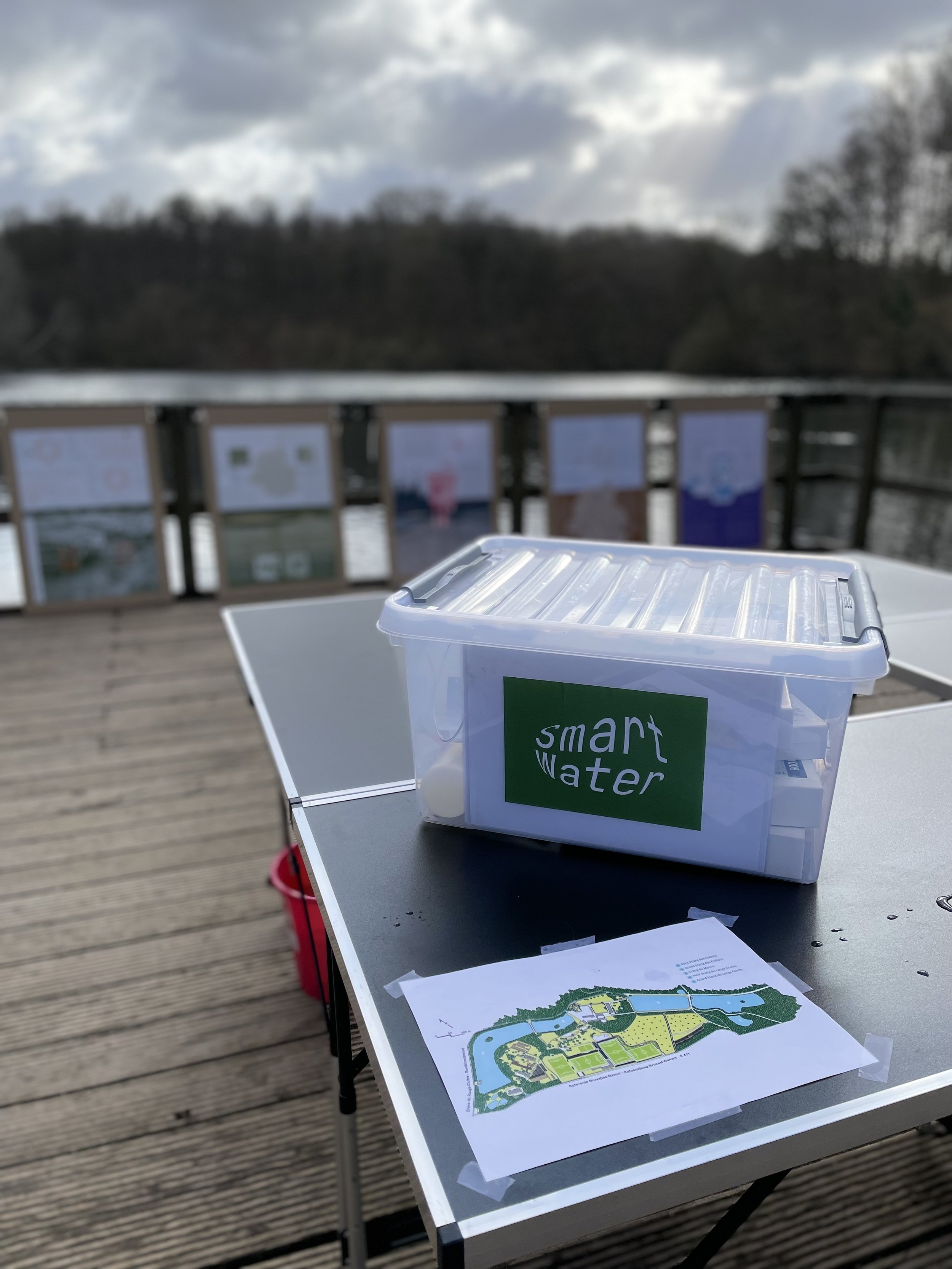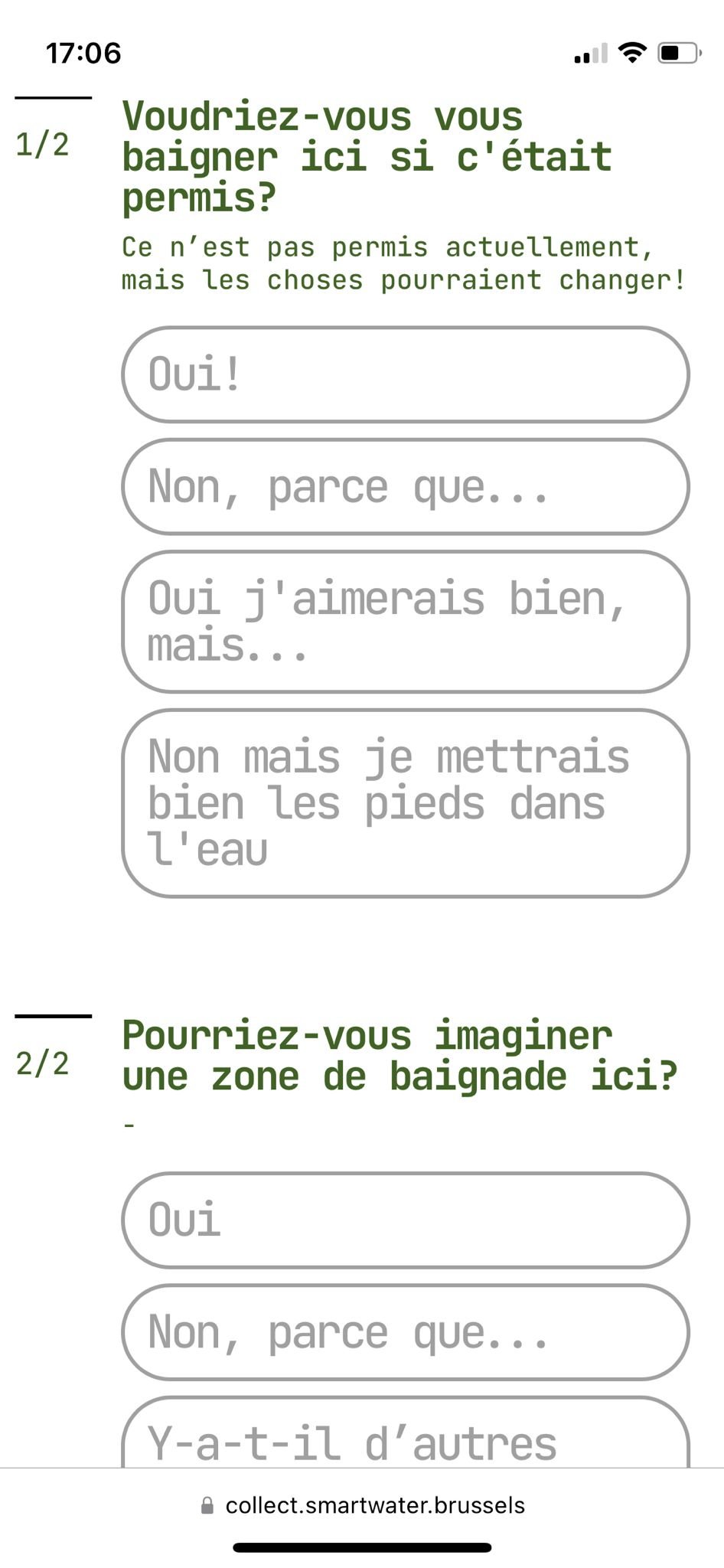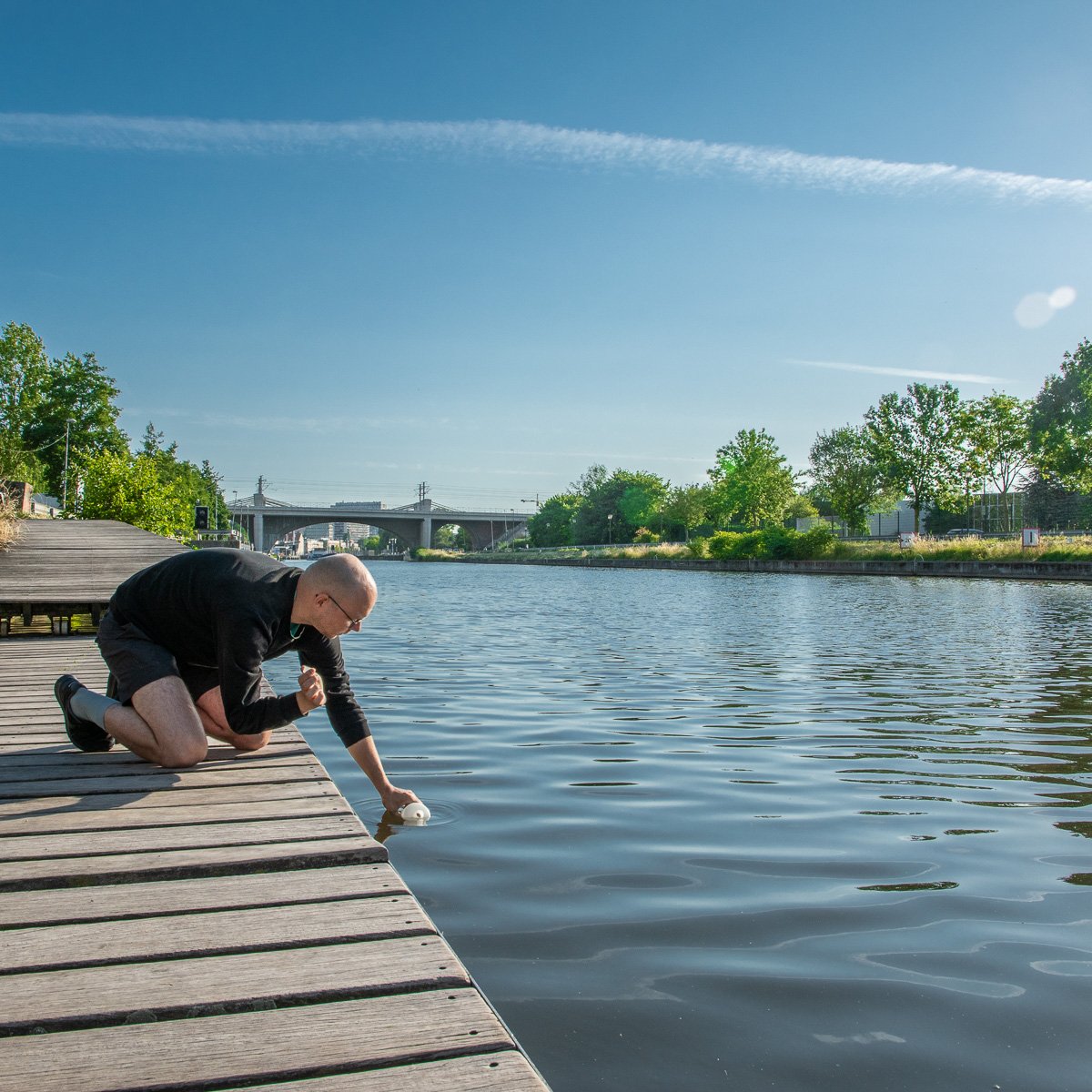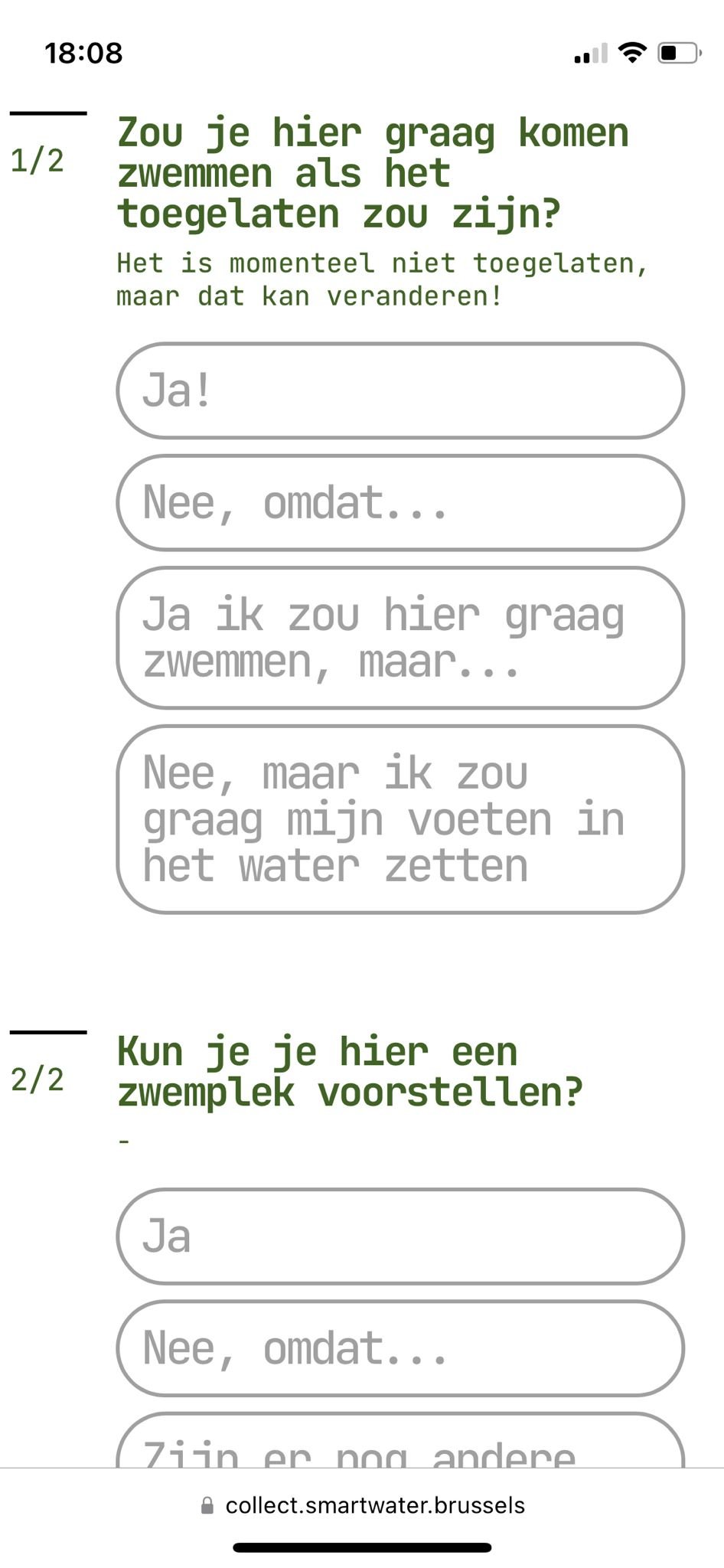OUTDOOR SWIMMING & WATER QUALITY
EN - The following article has been written by POOL IS COOL in the framework of SmartWater, a project aimed at better monitoring of the water quality of Brussel’s surface waters. POOL IS COOL was a partner of SmartWater from 2021 to 2023 and contributed to the project through offering perspectives from the side of the end user and through the organisation of public workshops to measure the water quality of the ponds at Rouge-Cloitre. While the project has come to an end, the tools developed by SmartWater are still in use and some even accessible to the public through sciencesaemporter.be or the SmartWater web application. The original article is available on the website of SmartWater.
FR - L'article suivant a été rédigé par POOL IS COOL dans le cadre de SmartWater, un projet visant à mieux surveiller la qualité des eaux de surface bruxelloises. POOL IS COOL a été partenaire de SmartWater de 2021 à 2023 et a contribué au projet en offrant des perspectives du côté de l'utilisateur final et en organisant des ateliers publics pour mesurer la qualité de l'eau des étangs de Rouge-Cloître. Bien que le projet soit arrivé à son terme, les outils développés par SmartWater sont toujours utilisés et certains sont même accessibles au public sur le site sciencesaemporter.be ou par l’application web de SmartWater. L'article original est disponible sur le site de SmartWater.
NL - Het volgende artikel werd geschreven door POOL IS COOL in het kader van SmartWater, een project gericht op een betere monitoring van de waterkwaliteit van de Brusselse oppervlaktewateren. POOL IS COOL was partner van SmartWater van 2021 tot 2023 en heeft bijgedragen aan het project door perspectieven te bieden vanuit de kant van de eindgebruiker en door het organiseren van openbare workshops om de waterkwaliteit van de vijvers in Rouge-Cloitre te meten. Hoewel het project is afgelopen, zijn de tools die SmartWater heeft ontwikkeld nog steeds in gebruik en toegankelijk voor het publiek via sciencesaemporter.be of de SmartWater web applicatie. Het originele artikel is beschikbaar op de website van SmartWater.
EN
OUTDOOR SWIMMING: A TANGIBLE WAY TO APPROACH WATER QUALITY
POOL IS COOL, a partner of SmartWater since the beginning of the project in 2021, has been advocating for the reintroduction of outdoor swimming in Brussels since 2015. Why? For more than 40 years, Brussels has not had any outdoor swimming opportunities, neither natural nor artificial. Believing strongly in the capacity of outdoor swimming to improve the living quality of a city like Brussels, POOL IS COOL has brought the topic back on the table through actions, projects, research and debate.
An action by POOL IS COOL in collaboration with Bozar: 'The biggest public outdoor pool in Brussels', 2017
Swimming and water quality monitoring: a close connection
Openair swimming and water quality are closely interrelated. Many countries and regions have regulations and standards in place to ensure the safety of recreational waters. Regular testing and adherence to water quality standards are essential for ensuring a safe swimming experience. However, in Brussels, only a small number of surface waters are being monitored regularly, which is one of the reasons why swimming is not recommended and even prohibited. The prohibition of swimming (or other aquatic activities) makes measuring the water quality on a regular basis not a necessity. In other countries, regular water quality tests are taken precisely because these waters are used for swimming and other recreational activities.
SmartWater aims to tackle the lack of data on water quality in the Brussels region by introducing diverse innovative monitoring tools such as the SmartWater web application, water quality measuring robots and the creation of SmartWater communities. By raising awareness and fostering civic engagement, the initiative contributes not only to improved water quality monitoring but also promotes the sustainable use of water. While the diverse SmartWater tools can facilitate swifter responses to potential problems, the comprehensive data collection can also help identify opportunities for potential utilisation of the water resources, such as swimming.
Water quality: a basic condition for diversified use of surface water
Good water quality is a basic condition for swimming. Bacteria, certain algae or chemicals present in the water can pose a serious health risk to animals as well as humans, causing waterborne illnesses and infections, skin irritations, or respiratory problems. Regular monitoring and maintenance of water quality are thus crucial to ensure that the water is safe for recreational use.
While oil films or dead fish floating on water surfaces are not inviting to swim, we still see (with concern) many people taking the risk of jumping into many of Brussels’ waters during the summer months, on the one hand because there are no other options, on the other hand because water quality is not necessarily visible. Water quality monitoring and communication are thus key for creating a safe swimming environment. In addition, not everyone has the time or means to take a trip to the already crowded Belgian coast, and other options in the European capital to cool down are scarce, if not existent. Not existent? Apart from one exception !
FLOW is not the solution, but an important Precedent
There is one small outdoor swimming pool that serves as a sustainable role model for future urban projects related to water and recreation: FLOW. Created by POOL IS COOL and situated in Anderlecht next to the Brussels canal, FLOW shows not only proof that swimming in Brussels can be made possible, but also that there is a real demand for public infrastructures (natural or artificial) allowing swimming to all citizens. Moreover, FLOW serves as a prototype for the application of a natural water filtering system, which is only possible since the introduction of a new local legislation on the operation of swimming pools this year. Unfortunately, FLOW itself cannot cover the huge demand due to its limited size, which is why POOL IS COOL keeps on looking for new swimming opportunities and continues to stir the debate.
The outdoor swimming pool FLOW in Anderlecht, 2021
Natural water filtering system at FLOW, installed in 2023 to replace the chemical treatment based on chlorine
People care for what they know
Good water quality for swimming does not always align with ecological value. Chlorinated pools may offer perfect conditions for swimming, yet they are essentially void of natural life and can cause skin irritations or worse. While such pools may meet the standards of clean water, they do not contribute to the ecological diversity and balance found in natural bodies of water.
People care more about what they know and what they have a positive experience with. In general, people are more likely to be concerned about water quality when engaging in recreational aquatic activities like swimming, as they come into direct contact with the water. It has been proved that swimming can have a positive effect on individuals’ well-being. Clean and clear water enhances the overall recreational experience. Swimmers are more likely to enjoy their time outdoors when the water is inviting, free from unpleasant odours, and visually appealing. Algae blooms, debris, or visible pollution can detract from the aesthetic appeal of the water and may discourage people from swimming.
Swimming can be a powerful tool for communicating the importance of water quality when individuals have a personal connection to the bodies of water they frequent. The positive experiences gained through swimming create a sense of ownership and responsibility for preserving the water quality. Local residents and recreational users may team up and advocate for policies and practices that support water quality improvement and protection.
As people become aware of the potential risks associated with poor water quality through projects such as SmartWater and FLOW, there is a greater likelihood that they will prioritise and advocate for measures to maintain clean and safe environments, which will eventually benefit nature as well as swimming lovers.
Where would you (not) like to swim?
SmartWater developed a web application where individuals can share all their observations about surface waters in the Brussels region with the public. Apart from questions concerning the water quality in specific, the observation forms also include a part about the biodiversity in and around, and the usage of the waters. Just as the surrounding biodiversity, the usage of a body of water and activities around it can also be a revealing indicator of water quality. If many people are swimming in the same body of water, we could assume that they consider the water quality as good enough for swimming (which does not mean that the water quality is actually good). On the other hand, hesitation or reluctance to swim may signal concerns about water quality, prompting further investigation into potential issues. Moreover, local myths (check our article about our stay in Logroño and the Siluro myth) and historical facts can also influence the experience around a water and the perception of water quality.
If it was not prohibited, where in Brussels would you like to take a dip?
Try out the SmartWater web application to share your experience around a specific body of water (in FR and NL).
Young people swimming in one of the ponds of Rouge-Cloître in Auderghem (a zone where swimming is prohibited). Is the water quality good enough to allow this activity? Through its monitoring tools, SmartWater can provide first insights.
FR
LA BAIGNADE EN PLEIN AIR : UNE MANIÈRE TANGIBLE D'ABORDER LA QUALITÉ DE L'EAU
POOL IS COOL, partenaire de SmartWater depuis le début du projet, plaide pour la réintroduction de la baignade en plein air à Bruxelles depuis 2015. Pourquoi ? Depuis plus de 40 ans, les Bruxellois.es n’ont pas eu la possibilité de se baigner en plein air, que ce soit en milieu naturel ou artificiel. Convaincue de la capacité de la baignade en plein air à améliorer la qualité des citoyens d’une ville comme Bruxelles, POOL IS COOL remet le sujet sur la table à travers des actions, des projets, de la recherche et des débats.
La baignade et la surveillance de la qualité de l'eau : un rapport intime
La baignade en plein air et la qualité de l'eau sont fortement liées. De nombreux pays et régions ont mis en place des réglementations et des normes pour garantir la sécurité des eaux de loisirs. Des analyses régulières et le respect des normes de qualité de l'eau sont essentiels pour garantir la sécurité de la baignade. Cependant, à Bruxelles, seul un petit nombre d'eaux de surface font l'objet d'une surveillance régulière, ce qui explique en partie pourquoi la baignade est déconseillée, voire interdite. L'interdiction de la baignade (ou d'autres activités aquatiques) ne rend pas nécessaire la mesure régulière de la qualité de l'eau, tandis que dans d'autres pays, des analyses périodiques sont effectuées précisément parce que ces eaux sont utilisées pour la baignade et d'autres activités récréatives.
SmartWater vise à remédier au manque de données sur la qualité de l'eau dans la région de Bruxelles en introduisant divers outils de surveillance innovants tels que l'application web SmartWater, des robots de mesure de la qualité de l'eau et la création de communautés SmartWater. En sensibilisant et en encourageant l'engagement civique, l'initiative contribue non seulement à améliorer la surveillance de la qualité de l'eau, mais aussi à promouvoir l'utilisation durable de l'eau. Si les divers outils SmartWater permettent de réagir plus rapidement aux problèmes potentiels, la collecte exhaustive de données permet également d'identifier les possibilités d'utilisation des ressources en eau, comme la baignade.
La qualité de l'eau : une condition de base pour une utilisation diversifiée des eaux de surface
Une bonne qualité de l'eau est une condition essentielle pour la baignade. Des bactéries, certaines algues ou des substances chimiques présentes dans l'eau peuvent constituer un risque sanitaire grave pour les animaux comme pour les êtres humains, en provoquant des maladies et des infections d'origine hydrique, des irritations de la peau ou des problèmes respiratoires. Il est donc essentiel de surveiller et d'entretenir régulièrement la qualité de l'eau pour s'assurer qu'elle peut être utilisée à des fins récréatives.
Alors que des films d'huile ou des poissons morts flottant à la surface de l'eau n'invitent pas à la baignade, nous voyons encore (avec inquiétude) de nombreuses personnes prendre le risque de sauter dans de nombreuses eaux bruxelloises pendant les mois d'été, d'une part parce qu'il n'y a pas d'autres options, d'autre part parce que la qualité de l'eau n'est pas nécessairement visible. La surveillance de la qualité de l'eau et la communication sont donc essentielles pour créer un environnement de baignade sans risque. En outre, il n’est pas donné à tout le monde d’avoir le temps ou les moyens de se rendre sur la côte belge, déjà très fréquentée, et les autres possibilités de se rafraîchir dans la capitale européenne sont rares, voire inexistantes. Inexistantes ? À une exception près !
FLOW n’est pas la solution, mais un important précédent
Il y existe une petite piscine en plein air qui sert de modèle durable pour les futurs projets urbains liés à l'eau et aux loisirs : FLOW. Créée par POOL IS COOL en 2021 et située à Anderlecht près du canal de Bruxelles, FLOW prouve non seulement que la baignade à Bruxelles peut être rendue possible (malgré la météo bèlge!), mais aussi qu'il existe une réelle demande d'infrastructures publiques (naturelles ou artificielles) permettant à tous les citoyens de se baigner en sécurité, gratuitement. De plus, FLOW sert de prototype pour l'application d'un système de filtrage naturel de l'eau, qui n'est possible que depuis l'introduction d'une nouvelle législation locale sur l'exploitation des piscines cette année. Malheureusement, FLOW ne peut pas répondre à l'énorme demande en raison de sa taille limitée. En effet, FLOW n'a jamais été conçu pour constituer la solution, mais pour illustrer le problème sous-jacent et proposer une approche qui peut être répliquée. C'est pourquoi POOL IS COOL continue à chercher de nouvelles possibilités de baignade et à alimenter le débat.
La piscine en plein air FLOW à Anderlecht, 2021
Système de filtrage naturel de l’eau de FLOW, installé en 2023, remplaçant le traitement de l’eau au chlore
Les citoyens se soucient de ce qu'ils connaissent
La bonne qualité de l'eau pour la baignade n'est pas toujours synonyme de durabilité écologique. Les piscines chlorées peuvent offrir des conditions parfaites pour la baignade, mais elles sont essentiellement exemptes de vie naturelle et peuvent provoquer des irritations de la peau, voire pire. Même si ces piscines répondent aux normes de propreté de l'eau, elles ne contribuent pas à la diversité et à l'équilibre écologique que l'on trouve dans les plans d'eau naturels.
Les gens se soucient davantage de ce qu'ils connaissent et de ce avec quoi ils ont eu une expérience positive. En général, les gens sont plus enclins à se préoccuper de la qualité de l'eau lorsqu'ils pratiquent des activités aquatiques récréatives telles que la baignade, car ils sont en contact direct avec l'eau. Il a été prouvé que la baignade peut avoir un effet positif sur le bien-être des individus. Une eau propre et claire améliore l'expérience récréative globale. Les nageurs sont plus susceptibles d'apprécier leur temps en plein air lorsque l'eau est accueillante, exempte d'odeurs désagréables, et visuellement attrayante. La prolifération d'algues, la présence de débris ou la pollution visible peuvent nuire à l'attrait esthétique de l'eau et décourager les gens de se baigner.
La baignade peut être un outil puissant pour communiquer l'importance de la qualité de l'eau lorsque les individus ont un lien personnel avec les milieux aquatiques qu'ils fréquentent. Les expériences positives acquises grâce à la baignade créent un sentiment d'appartenance et de responsabilité à l'égard de la préservation de la qualité de l'eau. Il se peut que les résidents locaux et les utilisateurs récréatifs s'associent et plaident en faveur de politiques et de pratiques qui soutiennent l'amélioration et la protection de la qualité de l'eau.
Lorsque les gens prennent conscience des risques potentiels associés à une mauvaise qualité de l'eau grâce à des projets tels que SmartWater et FLOW, il est plus probable qu'ils accordent la priorité aux mesures visant à maintenir des environnements propres et sûrs et qu'ils plaident en leur faveur, ce qui profitera finalement à la nature ainsi qu'aux passionnés de la baignade.
Où souhaiteriez-vous (ne pas) vous baigner ?
SmartWater a développé une application web permettant aux citoyens de partager avec le public toutes leurs observations sur les eaux de surface de la région bruxelloise. Outre les questions concernant la qualité de l'eau en particulier, les formulaires d'observation comprennent également une partie sur la biodiversité à l'intérieur et autour de l'eau, ainsi que sur l'utilisation des eaux. Tout comme la biodiversité environnante, l'utilisation d'un plan d'eau et les activités qui s'y déroulent peuvent également être un indicateur révélateur de la qualité de l'eau. Si de nombreuses personnes se baignent dans le même plan d'eau, on pourrait supposer qu'elles considèrent que la qualité de l'eau est suffisamment bonne pour se baigner (ce qui ne veut pas dire que la qualité de l'eau est réellement bonne). Inversement, l'hésitation ou la réticence à se baigner peut être le signe d'inquiétudes quant à la qualité de l'eau, ce qui incite à approfondir les recherches sur les problèmes potentiels. En outre, les mythes locaux (voir notre article sur notre séjour à Logroño et le mythe de Siluro) et les faits historiques peuvent également influencer l'expérience autour d'une eau et la perception de la qualité de l'eau.
Si ce n'était pas interdit, où iriez-vous vous baigner à Bruxelles ?
Testez vous-même l'application web SmartWater pour partager votre perception d'un plan d'eau spécifique dans la région bruxelloise.
Des jeunes qui se baignent dans un étang du Rouge-Cloître à Auderghem (une zone interdite à la baignade). La qualité de l’eau est-elle suffisamment bonne pour permettre cette activité? Par le biais de monitoring, SmartWater peut donner des premiers indices.
NL
OPENLUCHTZWEMMEN : EEN TASTBARE BENADERING TOT WATERKWALITEIT
POOL IS COOL, partner van SmartWater sinds het begin van het project, is sinds 2015 voorstander van de herinvoering van openluchtzwemmen in Brussel. Waarom? Al meer dan 40 jaar hebben de Brusselaars niet de kans gehad om buiten te zwemmen, zij het in een natuurlijke of kunstmatige omgeving. POOL IS COOL is ervan overtuigd dat zwemmen in de open lucht de levenskwaliteit van de inwoners van een stad als Brussel kan verbeteren, en legt de kwestie opnieuw op tafel door middel van acties, projecten, onderzoek en debat.
Zwemmen en waterkwaliteitscontrole: een intieme relatie
Zwemmen in de open lucht en waterkwaliteit zijn nauw met elkaar verbonden. Veel landen en regio's hebben regelgeving en normen ingevoerd om de veiligheid van recreatieve wateren te garanderen. Regelmatige analyses en naleving van de waterkwaliteitsnormen zijn essentieel om veilig zwemmen te garanderen. In Brussel wordt echter slechts een klein aantal oppervlaktewateren regelmatig gecontroleerd, wat deels verklaart waarom zwemmen niet wordt aanbevolen of zelfs verboden. Het verbod op zwemmen (of andere aquatische activiteiten) maakt regelmatige metingen van de waterkwaliteit niet noodzakelijk, terwijl in andere landen periodieke analyses worden uitgevoerd juist omdat deze wateren worden gebruikt voor zwemmen en andere recreatieve activiteiten.
SmartWater wil het gebrek aan gegevens over de waterkwaliteit in de Brusselse regio verhelpen door verschillende innovatieve monitoringinstrumenten te introduceren, zoals de SmartWater webapplicatie, robots voor het meten van de waterkwaliteit en de oprichting van SmartWater-gemeenschappen. Door het bewustzijn te verhogen en de betrokkenheid van burgers aan te moedigen, helpt het initiatief niet alleen om de controle van de waterkwaliteit te verbeteren, maar ook om het duurzame gebruik van water te bevorderen. Terwijl de verschillende SmartWater tools een snellere reactie op potentiële problemen mogelijk maken, helpt de uitgebreide verzameling van gegevens ook bij het identificeren van mogelijkheden voor het gebruik van wateren, zoals zwemmen.
Waterkwaliteit: een basisvoorwaarde voor gediversifieerd gebruik van oppervlaktewater
Een goede waterkwaliteit is essentieel om te kunnen zwemmen. Bacteriën, bepaalde algen of chemische stoffen in het water kunnen een ernstig gezondheidsrisico vormen voor zowel dieren als mensen en door het water overgedragen ziekten en infecties, huidirritaties of ademhalingsproblemen veroorzaken. Het is daarom essentieel om de waterkwaliteit regelmatig te controleren en te onderhouden om ervoor te zorgen dat het water voor recreatieve doeleinden kan worden gebruikt.
Hoewel films van olie of dode vissen die op het wateroppervlak drijven niet uitnodigen tot zwemmen, zien we nog steeds (met bezorgdheid) dat veel mensen het risico nemen om tijdens de zomermaanden in veel Brusselse wateren te springen, deels omdat er geen andere opties zijn, deels omdat de kwaliteit van het water niet noodzakelijk zichtbaar is. Controle van de waterkwaliteit en communicatie zijn dus essentieel om een zwemomgeving zonder risico's te creëren. Bovendien heeft niet iedereen de tijd of de middelen om naar de toch al drukke Belgische kust te reizen en zijn er weinig of geen andere mogelijkheden om verfrissing te vinden in de hoofdstad van Europa. Geen enkele mogelijkheid? Maar op één uitzondering na!
We zien deze collectieve organisatie van POOL IS COLD! als de eerste stap op weg naar de opbouw van een Brusselse koudwater community deze winter, en binnenkort ook deze lente. We plannen de volgende stap, de oprichting van een onafhankelijke koudwater zwemclub, voor na de zomer, en we zouden dat graag samen met jou doen! Doe je mee?
FLOW is niet de oplossing, maar een belangrijk precedent
Er is een klein openluchtzwembad dat dient als duurzaam model voor toekomstige stedelijke water- en vrijetijdsprojecten: FLOW. FLOW, in 2021 gecreëerd door POOL IS COOL en gelegen in Anderlecht nabij het Brusselse kanaal, bewijst niet alleen dat zwemmen in Brussel mogelijk is (ondanks het slechte weer!), maar ook dat er een reële vraag is naar openbare infrastructuren (natuurlijk of kunstmatig) die alle burgers in staat stellen om veilig en gratis te zwemmen. Daarnaast dient FLOW als prototype voor de inzet van een natuurlijk waterfiltersysteem, wat pas mogelijk is sinds de invoering van nieuwe lokale wetgeving voor de werking van zwembaden dit jaar. Helaas kan FLOW door zijn beperkte omvang niet aan de enorme vraag voldoen. FLOW is dan ook nooit ontworpen om de oplossing te zijn, maar om het onderliggende probleem te illustreren en een aanpak te bieden die kan worden overgenomen. Daarom blijft POOL IS COOL zoeken naar nieuwe zwemmogelijkheden en het debat stimuleren.
Het openluchtzwembad FLOW in Anderlecht, 2021
Het natuurlijke waterfiltratiesysteem van FLOW, geïnstalleerd in 2023, vervangt de chloorbehandeling van het water
Mensen geven om wat ze kennen
Een goede waterkwaliteit om in te zwemmen is niet altijd synoniem met ecologische duurzaamheid. Gechloreerde zwembaden bieden misschien perfecte omstandigheden om in te zwemmen, maar ze zijn in feite vrij van natuurlijk leven en kunnen huidirritatie of erger veroorzaken. Zelfs als deze zwembaden voldoen aan de normen voor schoon water, dragen ze niet bij aan de diversiteit en het ecologisch evenwicht die in natuurlijke waterlichamen te vinden zijn.
Mensen geven meer om wat ze kennen en waar ze een positieve ervaring mee hebben. Over het algemeen maken mensen zich meer zorgen over de waterkwaliteit als ze recreatieve wateractiviteiten ondernemen, zoals zwemmen, omdat ze dan direct in contact komen met het water. Het is bewezen dat zwemmen een positief effect heeft op het welzijn van mensen. Schoon, helder water verbetert de algehele recreatieve ervaring. Zwemmers zullen meer genieten van hun tijd in de buitenlucht als het water uitnodigend is, geen onaangename geuren verspreidt en er visueel aantrekkelijk uitziet. Algenbloei, vuil of zichtbare verontreiniging kunnen de esthetische aantrekkingskracht van het water verminderen en mensen ontmoedigen om te gaan zwemmen.
Zwemmen kan een krachtig middel zijn om het belang van waterkwaliteit over te brengen als mensen een persoonlijke band hebben met het watermilieu waar ze vaak naartoe gaan. De positieve ervaringen die met zwemmen worden opgedaan, creëren een gevoel van eigenaarschap en verantwoordelijkheid voor het behoud van de waterkwaliteit. Buurtbewoners en recreatieve gebruikers kunnen hun krachten bundelen en pleiten voor beleid en praktijken die de verbetering en bescherming van de waterkwaliteit ondersteunen.
Als mensen zich bewust worden van de potentiële risico's van een slechte waterkwaliteit door projecten zoals SmartWater en FLOW, zullen ze eerder prioriteit geven aan maatregelen om een schone en veilige omgeving te behouden en zich hiervoor inzetten, wat uiteindelijk zowel de natuur als zwemliefhebbers ten goede komt.
Waar zou jij (niet) willen zwemmen?
SmartWater heeft een webapplicatie ontwikkeld waarmee burgers al hun waarnemingen over de oppervlaktewateren van het Brusselse Gewest met het publiek kunnen delen. Naast vragen over de waterkwaliteit in het bijzonder, bevatten de observatieformulieren ook een onderdeel over de biodiversiteit in en rond het water, evenals het watergebruik. Net als de biodiversiteit in de omgeving kan ook het gebruik van een waterlichaam en de activiteiten die er plaatsvinden een veelzeggende indicator zijn voor de waterkwaliteit. Als veel mensen in hetzelfde water baden, kunnen we aannemen dat ze de waterkwaliteit goed genoeg vinden om in te baden (wat niet betekent dat de waterkwaliteit ook echt goed is). Omgekeerd kan aarzeling of terughoudendheid om te baden duiden op bezorgdheid over de waterkwaliteit, wat aanzet tot verder onderzoek naar mogelijke problemen. Daarnaast kunnen lokale mythen (bekijk ons artikel over ons bezoek in Logroño en de Siluro mythe)en historische feiten ook van invloed zijn op de beleving van water en de perceptie van de waterkwaliteit.
Als het niet verboden was, waar zou je dan gaan zwemmen in Brussel?
Test zelf de webapplicatie van SmartWater en deel jouw perceptie van een specifiek water in de Brusselse regio.
Jongeren zwemmen in een vijver in Rouge-Cloître in Oudergem (een gebied waar zwemmen verboden is). Is de waterkwaliteit goed genoeg voor deze activiteit? Via monitoring kan SmartWater enkele eerste aanwijzingen geven.




